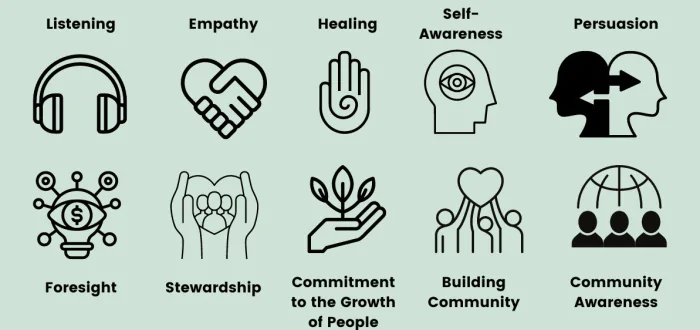Servant Leadership - A New Form of Leadership?
The Concept of Servant Leadership
The concept of Servant Leadership assumes that a leader is first and foremost a servant or sidekick. Sounds strange, doesn't it? People usually think that the boss or chief executive is the person who commands, and the others follow. But Servant Leadership turns that notion around.
In this case, your boss would not be the one telling you what to do, but the one asking you what you need to do your job well. He's there to remove obstacles, give you the tools you need, and make you feel comfortable and valued. A boss would also be someone who helps you develop, learn new skills, and grow as a person as well as a professional. His or her main role would be to support you so that you can do your best.
The basic assumption is based on the fact that if you do your best, the entire company will implement it as well. When all employees feel valued, supported and motivated, they are more engaged, productive and creative. They contribute more ideas, collaborate better, and are sick less often. And all of this is, of course, good for the company.
That, in simple terms, is what Servant Leadership is all about. It's not about exercising power, it's about serving. And by serving, the leader ultimately helps the whole company become better.
Where Does the Term Servant Leadership Come From?
The term Servant Leadership was coined by Robert K. Greenleaf in the essay "The Servant as Leader" (1970). Greenleaf was not a typical businessman, but worked for a telephone company for many years and had the chance to observe many different leaders. He noticed that the most effective and inspiring leaders were those who cared about and served their employees, rather than just commanding them.
Greenleaf derived the ideas and the name from the book "Journey to India" by Hermann Hesse. In this novel, the protagonist encounters a group of people led by a “servant”. This image inspired him to develop the concept of Servant Leadership. After publishing the essay, Greenleaf founded the Greenleaf Center for Servant Leadership in 1977. The organization is committed to raising awareness of servant leadership and helping people and organizations implement this style of leadership.
For more in-depth information, you can go directly to the Greenleaf Center for Servant Leadership website, or read his original essay, "The Servant as Leader". It is important to note that many of his writings and books are still considered important resources in the leadership literature today.
His concept of Servant Leadership remains very different from other leadership styles and is used today, especially in the agile workspace, to lead self-directed teams.
Often, Servant Leadership is compared or portrayed primarily with two leadership styles:

- Authoritarian Leadership:
Here, the boss is the boss, giving orders that employees must follow. There is little room for discussion or creativity on the part of the employees. They are there to do what they are told. All decisions are strictly hierarchical. In contrast, Servant Leadership is about supporting employees, encouraging them to contribute their ideas and creativity, and promoting their development. - Transformational Leadership:
The supervisor here is someone who inspires and motivates, has a vision, and gets employees to share and work for that vision. That sounds pretty good, right? But the difference with Servant Leadership is that in transformational leadership style, the end goal is often the boss's vision. Servant Leadership, on the other hand, focuses on the well-being and development of the employees, and the assumption is that this will ultimately benefit the company.
What Are the Ten Characteristics of a Servant Leader?
According to Larry C. Spears, an expert in the field of Servant Leadership, a servant leader has ten special character traits.
Larry C. Spears, a prominent author, speaker and researcher in the field of Servant Leadership, served as president and CEO of the Robert K. Greenleaf Center for Servant Leadership from 1990 to 2007. During his tenure, Spears identified ten distinctive characteristics of servant leadership from the writings of Robert Greenleaf.

In what follows, I will attempt to explain these ten characteristics:
- Listening:
Servant Leaders are like human sponges when it comes to absorbing information. They actively listen to what their employees are saying instead of just paying attention to their own voice. - Empathy:
Think of empathy as the ability to step into another person's shoes. Servant Leaders really try to understand their employees' feelings and concerns and show that they care. - Healing:
Healing here does not mean curing someone of a disease. Rather, it means creating an atmosphere where people can address their problems and find solutions. It is about creating a supportive environment. - Self-Awareness:
Servant leaders have a mirror into which they look and see themselves - metaphorically speaking. They understand their strengths and weaknesses and how their behavior affects others. - Persuasion:
Instead of directing people with the metaphorical hammer of authority, Servant Leaders use gentle persuasion. They build consensus and encourage others to commit to a cause of their own free will. - Foresight:
Servant leaders possess a crystal ball that allows them to see into the future - but only figuratively. They can see patterns and assess the possible consequences of decisions before they make them. - Stewardship:
Stewardship means that servant leaders act like janitors who look after a building. Except that in this case, the building is the company or team. They take their responsibilities seriously and make sure everything is running well and developing. - Commitment to the Growth of People:
Servant Leaders are like gardeners who help plants grow. Only here, the plants are people. They care about their people growing and developing, both professionally and personally. - Building Community:
They are like the captain of a ship, making sure everyone on board works together and supports each other. They encourage teamwork and make everyone feel part of a community. - Community Awareness:
A Servant Leader thinks not only about his own team or company, but also about the community outside. He asks himself how decisions might affect society as a whole and works for the good of all.
These ten characteristics help a servant leader create a supportive and productive environment in which employees can thrive. However, it is important to note that not every leader needs to possess all of these characteristics in equal measure to be effective. Rather, it's about finding a balance and developing a leadership style that fits the individual and situation.
How Can Servant Leadership Improve Organizational Performance?
Implementing Servant Leadership as a consulting approach in a company can be a powerful way to improve the company's culture and performance. It is basically about creating an environment where the needs of employees are brought to the forefront and their development is encouraged.
Here are some steps that might help introduce the Servant Leadership approach:
- Create Awareness:
It is important that everyone in the organization, especially senior managers, understand the concept of servant leadership and recognize its value. This can be achieved through workshops, seminars or individual coaching. - Leaders as Role Models:
Leaders play a critical role in the transition to Servant Leadership. They should model the principles of Servant Leadership, such as active listening, showing empathy, and encouraging employee growth. - Solicit Employee Feedback:
to truly understand employee needs, a feedback system should be established that allows employees to express their thoughts, ideas and concerns. - Create an Environment for Growth:
This can be achieved through continuous learning and development programs, mentoring, and providing resources to help employees grow their skills and knowledge.
The Benefits of Servant Leadership can be many in such an Implementation:
- Employee Satisfaction:
When employees feel their needs are considered and valued, it often leads to higher satisfaction and motivation. - Team Cohesion:
Servant Leadership can lead to stronger team dynamics and collaboration because it focuses on community and mutual support. - Innovation:
Because servant leadership encourages employee development and growth, it can create an environment that fosters innovation and creativity.
However, there are also potential drawbacks or challenges that need to be considered:
- Time Required:
Implementing servant leadership can take time and requires real culture change, which is not always easy. - Misconceptions:
Some people may misinterpret Servant Leadership and see it as a weakness, which could lead to a lack of respect. - Finding Balance:
It can be challenging to find the balance between serving and leading, especially in situations where quick decisions are required.
It is important to consider these issues and take a prudent approach when implementing Servant Leadership in an organization.
When Does It Make Sense to Implement Servant Leadership?
Introducing servant leadership as a leadership style can make sense in a variety of contexts in an organization. Here are some situations where the introduction of Servant Leadership could be particularly useful:
- Culture Change:
When an organization is undergoing or seeking a culture change - for example, toward greater employee-centricity, collaboration, or innovation - servant leadership can be an effective approach. It can help create a culture of care and respect that promotes these values. - Improve Employee Engagement:
If a company is having problems with employee motivation or engagement, Servant Leadership can be a solution. By focusing on employee needs and development, it can lead to higher satisfaction and engagement. - Strengthen Teamwork:
In organizations where teamwork and collaboration are critical, Servant Leadership can help foster a stronger sense of community and more effective collaboration. - Solve Leadership Problems:
When there are leadership problems in an organization - such as a lack of leadership quality or a leadership culture based on control and authority - Servant Leadership can make a positive difference. It can help create a leadership culture based on employee support and development.
However, it is important to note that implementing Servant Leadership requires significant culture change and cannot happen overnight. It requires commitment, patience and continuity to embed this type of leadership culture in the company.


